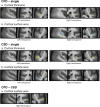Surface-Based Morphometry of Cortical Thickness and Surface Area Associated with Heschl's Gyri Duplications in 430 Healthy Volunteers
- PMID: 27014013
- PMCID: PMC4779901
- DOI: 10.3389/fnhum.2016.00069
Surface-Based Morphometry of Cortical Thickness and Surface Area Associated with Heschl's Gyri Duplications in 430 Healthy Volunteers
Abstract
We applied Surface-Based Morphometry to assess the variations in cortical thickness (CT) and cortical surface area (CSA) in relation to the occurrence of Heschl's gyrus (HG) duplications in each hemisphere. 430 healthy brains that had previously been classified as having a single HG, Common Stem Duplication (CSD) or Complete Posterior Duplication (CPD) in each hemisphere were analyzed. To optimally align the HG area across the different groups of gyrification, we computed a specific surface-based template composed of 40 individuals with a symmetrical HG gyrification pattern (20 single HG, 10 CPD, 10 CSD). After normalizing the 430 participants' T1 images to this specific template, we separately compared the groups constituted of participants with a single HG, CPD, and CSD in each hemisphere. The occurrence of a duplication in either hemisphere was associated with an increase in CT posterior to the primary auditory cortex. This may be the neural support of expertise or great abilities in either speech or music processing domains that were related with duplications by previous studies. A decrease in CSA in the planum temporale was detected in cases with duplication in the left hemisphere. In the right hemisphere, a medial decrease in CSA and a lateral increase in CSA were present in HG when a CPD occurred together with an increase in CSA in the depth of the superior temporal sulcus (STS) in CSD compared to a single HG. These variations associated with duplication might be related to the functions that they process jointly within each hemisphere: temporal and speech processing in the left and spectral and music processing in the right.
Keywords: FreeSurfer; Heschl's gyrus; MRI; anatomy; cortical surface area; cortical thickness; gyrification; hemispheric specialization.
Figures




Similar articles
-
Variations of planum temporale asymmetries with Heschl's Gyri duplications and association with cognitive abilities: MRI investigation of 428 healthy volunteers.Brain Struct Funct. 2017 Aug;222(6):2711-2726. doi: 10.1007/s00429-017-1367-5. Epub 2017 Feb 6. Brain Struct Funct. 2017. PMID: 28164245
-
Descriptive anatomy of Heschl's gyri in 430 healthy volunteers, including 198 left-handers.Brain Struct Funct. 2015 Mar;220(2):729-43. doi: 10.1007/s00429-013-0680-x. Epub 2013 Dec 6. Brain Struct Funct. 2015. PMID: 24310352 Free PMC article.
-
Intracortical Myelination of Heschl's Gyrus and the Planum Temporale Varies With Heschl's Duplication Pattern and Rhyming Performance: An Investigation of 440 Healthy Volunteers.Cereb Cortex. 2019 May 1;29(5):2072-2083. doi: 10.1093/cercor/bhy088. Cereb Cortex. 2019. PMID: 29912300
-
Auditory cortex asymmetry, altered minicolumn spacing and absence of ageing effects in schizophrenia.Brain. 2008 Dec;131(Pt 12):3178-92. doi: 10.1093/brain/awn211. Epub 2008 Sep 26. Brain. 2008. PMID: 18819990 Free PMC article. Review.
-
[Auditory perception and language: functional imaging of speech sensitive auditory cortex].Rev Neurol (Paris). 2001 Sep;157(8-9 Pt 1):837-46. Rev Neurol (Paris). 2001. PMID: 11677406 Review. French.
Cited by
-
Morphological Features of Language Regions in Individuals with Tuberous Sclerosis Complex.J Autism Dev Disord. 2024 Aug;54(8):3155-3175. doi: 10.1007/s10803-023-06004-8. Epub 2023 May 24. J Autism Dev Disord. 2024. PMID: 37222965
-
Gross anatomical features of the insular cortex in affective disorders.Front Psychiatry. 2024 Dec 9;15:1482990. doi: 10.3389/fpsyt.2024.1482990. eCollection 2024. Front Psychiatry. 2024. PMID: 39717373 Free PMC article.
-
Different Frequency of Heschl's Gyrus Duplication Patterns in Neuropsychiatric Disorders: An MRI Study in Bipolar and Major Depressive Disorders.Front Hum Neurosci. 2022 Jun 13;16:917270. doi: 10.3389/fnhum.2022.917270. eCollection 2022. Front Hum Neurosci. 2022. PMID: 35769254 Free PMC article.
-
Using high spatial resolution fMRI to understand representation in the auditory network.Prog Neurobiol. 2021 Dec;207:101887. doi: 10.1016/j.pneurobio.2020.101887. Epub 2020 Aug 1. Prog Neurobiol. 2021. PMID: 32745500 Free PMC article. Review.
-
Anatomical Variations of the Auditory Cortex and their Clinical Significance, Prevalence and a Review of the Literature.Acta Med Acad. 2025 Apr;54(1):18-26. doi: 10.5644/ama2006-124.470. Acta Med Acad. 2025. PMID: 40197085 Free PMC article. Review.
References
-
- Barrick T. R., Mackay C. E., Prima S., Maes F., Vandermeulen D., Crow T. J., et al. . (2005). Automatic analysis of cerebral asymmetry: an exploratory study of the relationship between brain torque and planum temporale asymmetry. Neuroimage 24, 678–691. 10.1016/j.neuroimage.2004.09.003 - DOI - PubMed
LinkOut - more resources
Full Text Sources
Other Literature Sources

